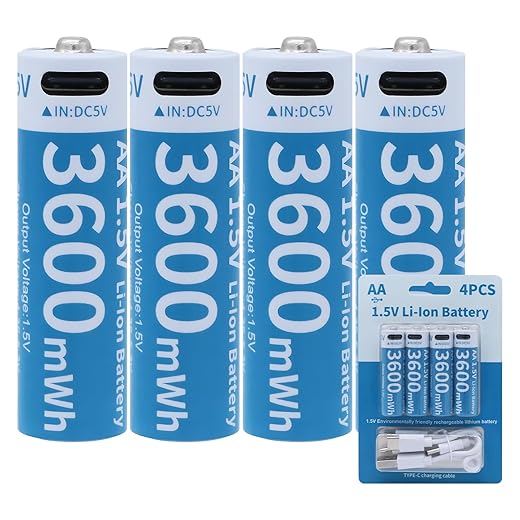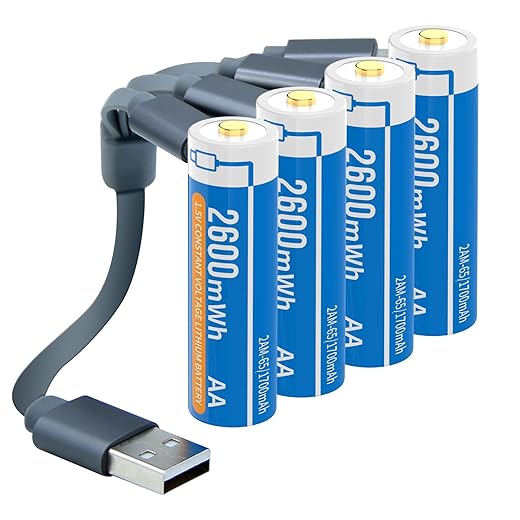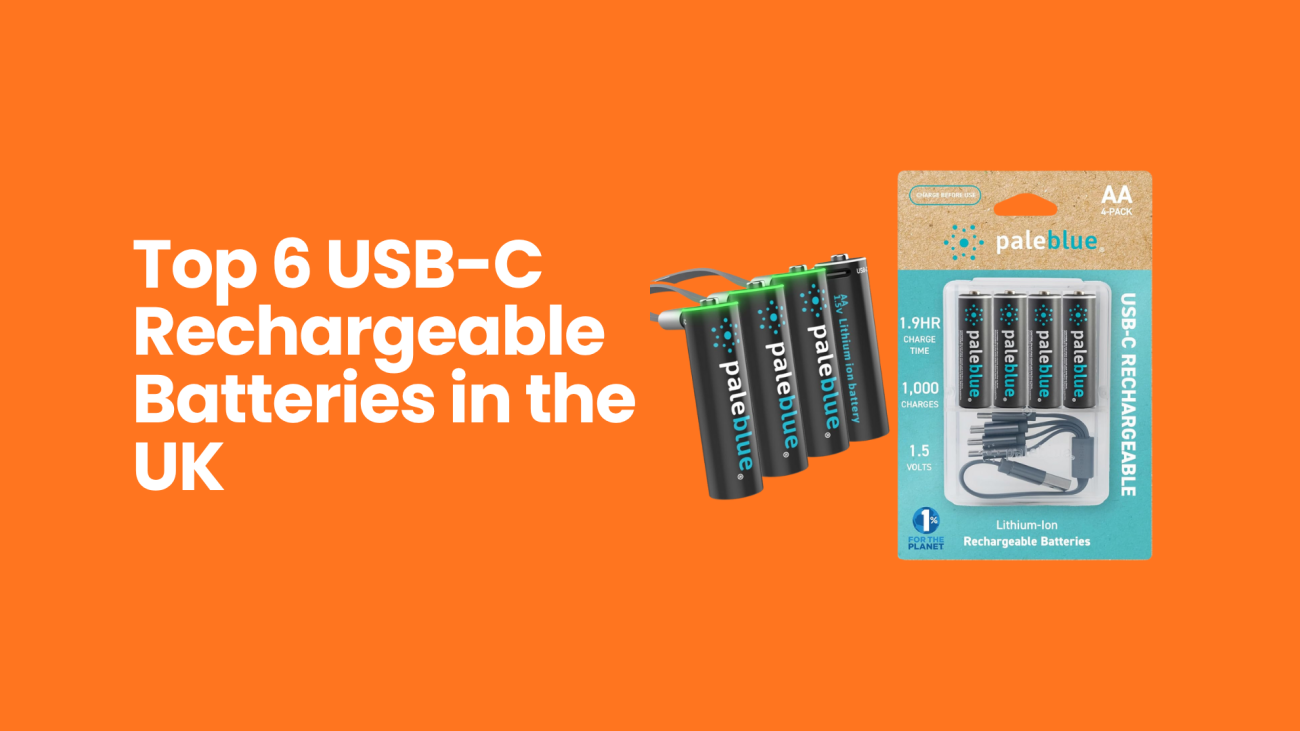Tired of hunting for AAAs at 2 a.m.? Charge, click, repeat — the future fits a USB‑C cable.
Stop throwing money at disposables. A single USB‑C cable can replace a drawer full of dead cells and a guilt trip about landfill.
They want power that’s FAST, SIMPLE and RELIABLE. These rechargeable AA/AAA packs promise steady 1.5V output, quick USB‑C top‑ups and fewer trips to the shops.
Top Picks






paleblue USB-C Rechargeable AA Pack
Delivers very fast USB-C charging and a steady 1.5V output suitable for most household devices. It balances speed, cycle life and convenience, making it a strong all-round choice for people who want to replace disposables.
Purpose and positioning
The paleblue USB-C Rechargeable AA pack is aimed at households and power‑hungry devices where fast turnaround and a true 1.5V output matter. It combines lithium‑ion chemistry with an onboard USB‑C port so each cell can be recharged directly without a separate dock.
Key features and benefits
These features are practical: the fast charge means controllers, toys or camera accessories can be back in service quickly; the 1.5V output avoids the compatibility issues of 1.2V NiMH cells in legacy clocks or radio sync hardware.
Limitations and practical insights
Some buyers reported a small number of DOA or early‑fail units, so test new packs when they arrive and keep proof of purchase. Also, because the charging electronics are built into the cell body, users must avoid charging them in standard battery docks — attempting to do so can be unsafe.
Real‑world use and verdict
Users frequently praise the speed and convenience: "fast easy charging via USB, LED display notifies you once charged" is a common theme in reviews. For people who travel, use power banks, or need quick swaps for cameras and controllers, this pack is a very practical upgrade. For those who prioritise absolute rock‑solid QC, it’s worth buying from a retailer with a reasonable returns window.
Delyeepow USB-C Rechargeable AAA Set
Offers very quick one‑hour USB-C charging and a steady 1.5V output that suits many remote controls and low‑drain electronics. It’s a cost‑effective pack for users who want convenience without carrying a separate charger.
What it does best
The Delyeepow AAA USB‑C rechargeable set targets users who need compact AAA cells with fast turnaround. These cells deliver a constant 1.5V and are intended to be recharged directly via USB‑C, eliminating a separate charging cradle.
Standout specifications
The 1.5V behavior is particularly useful: many remote controls and certain toys expect 1.5V and can behave poorly with 1.2V NiMH cells. Quick recharging from a laptop or power bank is convenient during travel or events.
Caveats and user experience
While many reviewers report excellent hold time in remotes and scales, a few users found runtimes shorter than expected in very high‑drain applications (for example long strings of LED lights). A small number of customers mentioned unreliable cable ends — swapping the cable fixed the issue in most cases.
Final take
For people who want a fast, compact AAA solution and value the constant 1.5V, this pack is a sensible, budget‑friendly option. It’s best for low‑to‑moderate drain devices rather than sustained high‑power applications like powerful torches or professional camera rigs.
ENEGON USB‑C Rechargeable AAA Batteries
A solid, convenient AAA option that provides 1.5V output and direct USB‑C charging for everyday gadgets. It’s a practical pick for remotes, small electronics and travel kits where portability and speed matter.
Who it’s for
ENEGON’s AAA rechargeable set is ideal for people who want the convenience of direct USB‑C charging for small household devices. It removes the need to carry a separate charging dock and works well with laptops, phone chargers and power banks.
Core advantages
This makes the pack handy for wireless mice, TV remotes, small flashlights and travel gadgets. The 1.5V output ensures maximum compatibility with devices that expect alkaline voltages.
Real‑world caveats
Some users have noted self‑discharge and capacity lower than the stated value; these concerns appear in a minority of reviews. Additionally, very high‑drain applications (strong torches, professional hardware) will still favor dedicated high‑current cells or external battery solutions.
Bottom line
For everyday use and travel convenience, these AAA batteries are a practical and popular choice. They strike a good balance between portability and performance for the majority of household devices.
Tosiicop High‑Output USB‑C AA Batteries
Promises a large 3600mWh capacity with fast charging and multiple protections, making it attractive for high‑demand users. Real‑world results are mixed: some buyers report excellent life, while others saw disappointing runtimes in specific low‑power installations.
Overview
Tosiicop markets these AA cells to users who want maximum runtime from a USB‑charged AA battery. With a very large claimed capacity and support for direct charging, the pack is engineered for high‑draw toys, flashguns and prolonged gadget use.
Features and expected benefits
In theory, the high capacity is ideal for devices that draw sustained current; the direct USB method makes replenishing simple without a separate cradle.
Practical observations and limitations
Several reviewers praised the convenience and battery reach in gaming and hobbyist applications. However, some tests revealed drastically shorter runtimes than the spec sheet suggests — this discrepancy could be down to measurement conditions, device draw profile, or overstated advertising.
Recommendation
For hobbyists who want the longest possible runtime from an AA with USB convenience, this pack is worth trialing — but buyers should validate real performance in their specific devices and retain the option to return if runtimes do not meet expectations.
Henreepow High‑Capacity USB‑C AA Pack
Provides a very attractive high nominal capacity and built‑in USB charging at a low price point. Performance is generally good for many applications, though quality and consistency vary between batches.
Positioning and intended users
The Henreepow AA pack is pitched at cost‑conscious buyers who still want high capacity and USB convenience. It aims to replace disposable AAs in home electronics while offering quick, direct charging.
Key specifications and uses
This combination makes the pack useful for doorbells, cameras, toys and game controllers. The higher capacity rating is appealing for users wanting longer intervals between charges.
Limitations and real‑world notes
Several reviews point to variability: some users report excellent multi‑week performance in doorbell cameras, while others found cells arriving low or failing early. Henreepow advises initial conditioning cycles for top performance (charge fully 3–5 times).
Verdict and recommendation
If the price is a priority and the device tolerates USB‑charged cells, this pack is a pragmatic pick. Buyers should test each cell on arrival and be prepared to return any defective items. For mission‑critical or professional uses, a more established brand might be preferable.
Budget USB‑C Rechargeable AA 4‑Pack
A low‑cost entry into USB‑C rechargeable AAs that performs well in low to moderate drain devices. It offers fast charging and good short‑term runtime, but capacity and longevity may not match premium alternatives.
Product intent
This budget 4‑pack targets shoppers who want the convenience of USB‑C rechargeable AAs without a large outlay. It is most suitable for clocks, nightlights, remote controls and other low‑to‑moderate drain items.
Specs and practical benefits
The immediate benefit is convenience: users can plug into any USB power source and charge multiple cells at once, which simplifies trips and reduces reliance on single‑use batteries.
Drawbacks and real‑world performance
A number of reviewers highlight that these cheaper cells don't always match the capacity or longevity of established brands in high‑drain gear like powerful torches or professional devices. There are occasional reports of premature failure, so buyers should test new packs promptly and keep purchase records.
Who should buy these?
These cells are a good fit for households wanting to cut disposables for everyday low‑power gadgets and who appreciate the simplicity of USB charging. For mission‑critical equipment or very high drain applications, it’s better to invest in higher‑end cells with verified independent test results.
Final Thoughts
For most people the paleblue USB‑C Rechargeable AA Pack is the clear winner. It balances very fast USB‑C charging, a steady 1.5V output and solid cycle life — ideal for everyday household devices (toys, remotes, wireless mice) and users who want a dependable all‑rounder.
For AAA needs and ultra‑fast top‑ups, the Delyeepow USB‑C Rechargeable AAA Set is the best pick. Its one‑hour charge time and 1.5V output make it perfect for remote controls, small gadgets and travel kits where quick turnaround matters.
Buying Guide: How to choose USB‑C rechargeable batteries
Choosing the right USB‑C rechargeable AA/AAA is about matching real‑world needs to what the cells deliver. They should consider five key areas: voltage compatibility, charge speed, capacity, cycle life and safety protections.
Voltage and device compatibility
Charge speed vs. longevity
Capacity and real‑world runtime
Safety and build quality
Practical purchase tips
Quick checklist before buying
By focusing on compatibility, realistic runtime expectations and safety, they can pick a USB‑C rechargeable pack that actually simplifies life — and keeps devices powered without the landfill drama.
FAQ
They can in most household gadgets because many of these cells deliver a steady 1.5V. However, for devices that demand ultra‑long standby life (like smoke alarms) or very high continuous currents (some pro camera flashes), dedicated solutions are still preferable. Check device specs and manufacturer recommendations.
Many modern devices work fine with 1.2V NiMH cells, but some toys and electronics expect 1.5V and show erratic behaviour with 1.2V. The USB‑C cells reviewed here step up to 1.5V, which improves compatibility with older gear while preserving rechargeable benefits.
Runtime varies by device and drain. High‑drain gadgets will deplete cells faster than remotes. Cycle life depends on build quality — premium packs like paleblue tend to offer more predictable longevity, while value packs may show greater batch variability. Expect hundreds of cycles if used and charged correctly.
Most modern USB‑C rechargeable cells include protection circuits against overcharge, overheating and short circuits. That said, it’s still sensible to use good cables and avoid damaged batteries. For safety, charge on a hard surface and avoid covering them with bedding or cushions.
mWh is a valid energy unit, but it’s more common to see mAh. To compare, convert using voltage (mWh ÷ V ≈ mAh). Marketing numbers can be optimistic; prioritize real‑world reviews and consistent performance over raw specs.
No — these cells charge directly via a USB‑C port built into the batteries, so a spare USB‑C cable and a decent USB charger are all that’s needed. Faster chargers yield quicker top‑ups, but avoid using extremely high‑wattage chargers unless the manufacturer states compatibility.

